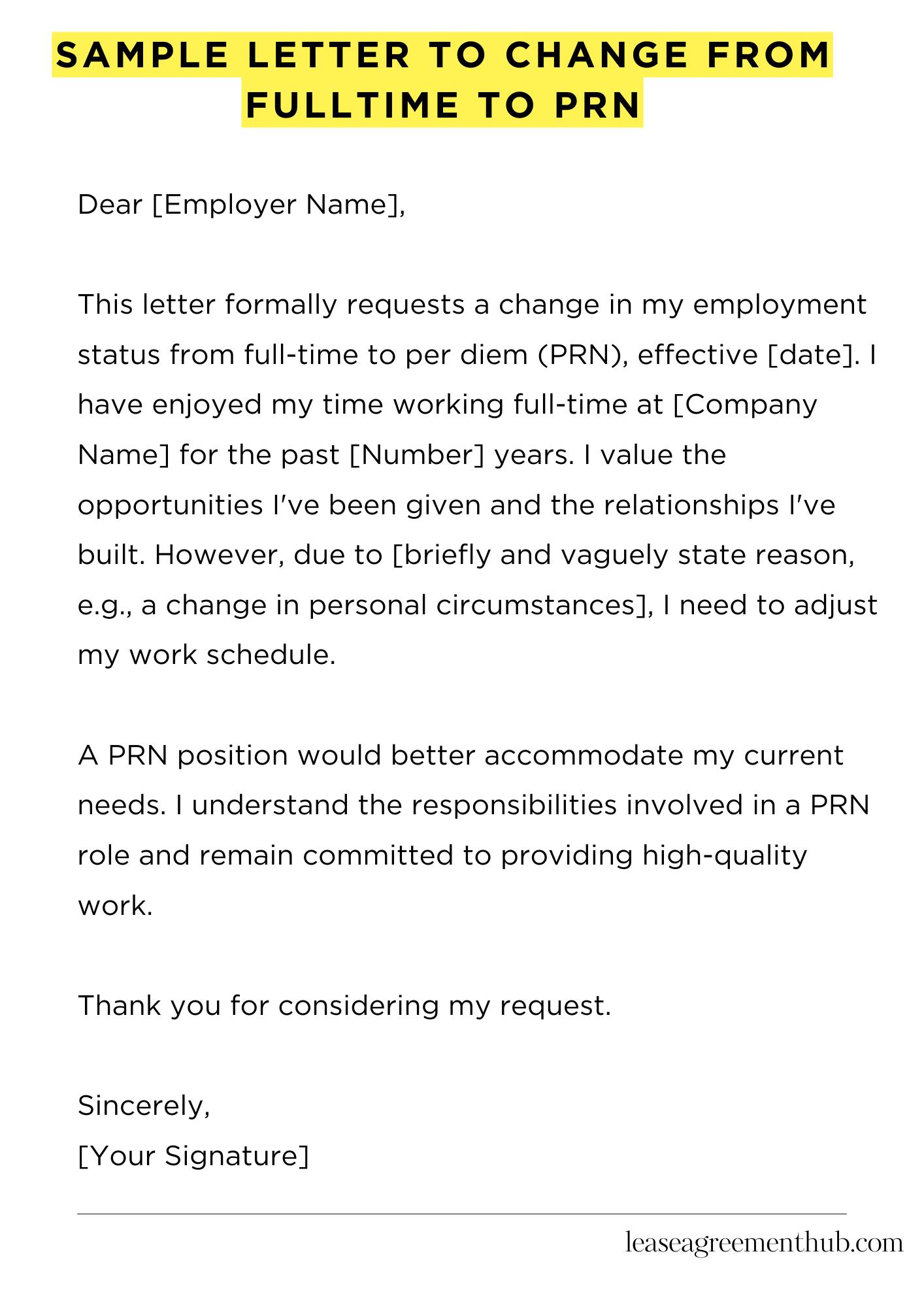Want to switch from full-time to PRN? Need a letter? This article helps.
We’ll give you sample letters. Use them as templates. Make writing your letter easy.
These examples are ready to use. Customize them. Get your request across clearly.
Sample Letter to Change from Full-time to PRN
[Your Name]
[Your Address]
[Your Phone Number]
[Your Email Address]
[Date]
[Employer Name]
[Employer Address]
Dear [Employer Name],
This letter formally requests a change in my employment status from full-time to per diem (PRN), effective [date]. I have enjoyed my time working full-time at [Company Name] for the past [Number] years. I value the opportunities I’ve been given and the relationships I’ve built. However, due to [briefly and vaguely state reason, e.g., a change in personal circumstances], I need to adjust my work schedule.
A PRN position would better accommodate my current needs. I understand the responsibilities involved in a PRN role and remain committed to providing high-quality work. My skills and experience in [mention relevant skills/department] are readily available to support the team. I am flexible and willing to work on a variety of assignments as needed.
I am confident I can continue to make significant contributions to [Company Name] in this new capacity. Please let me know if you require any further information or would like to discuss this change further. I am available to meet at your earliest convenience.
Thank you for considering my request.
Sincerely,
[Your Signature]

How to Write a Sample Letter to Change from Full-Time to PRN
Understanding the Nuances of PRN Employment
Before drafting your letter, meticulously consider the implications of transitioning from a full-time position to a per-diem, or PRN (pro re nata), role. This shift often entails a significant alteration in your compensation structure, benefits eligibility, and scheduling predictability. Thoroughly analyze your personal financial situation and healthcare needs to ensure this change aligns with your long-term goals. A clear understanding of these ramifications will inform the tone and content of your letter.
Structuring Your Salutation and Introduction
Begin with a formal salutation, addressing your supervisor or the relevant HR representative by name and title. Avoid colloquialisms; maintain a professional, yet personable, tone. Concisely state your intention to request a change in employment status from full-time to PRN. This introductory paragraph sets the stage for a cogent and persuasive argument.
Articulating Your Reasons for the Transition
This section is paramount. Offer a succinct yet comprehensive explanation for your desire to transition. Be forthright, but avoid overly personal details. Focus on reasons that highlight your continued commitment to the organization, such as a desire for enhanced work-life balance, the need for increased schedule flexibility, or pursuing supplementary educational opportunities. Avoid negativity; frame your reasoning positively.
Addressing Potential Concerns Proactively
Anticipate potential employer concerns. Will your reduced availability impact workflow or team performance? Address these directly. Perhaps offer suggestions for mitigating any challenges. Demonstrate your proactive approach and commitment to minimizing disruption. A thoughtful response showcases your professionalism and dedication.
Negotiating Your PRN Schedule and Compensation
Clearly outline your desired PRN schedule, specifying your availability. If applicable, negotiate your compensation rate for PRN work, ensuring it aligns with your needs and industry standards. Research comparable rates for similar positions to inform your request. Approach this negotiation strategically and diplomatically.
Concluding with Professionalism and Contact Information
End your letter with a professional closing, such as “Sincerely” or “Respectfully.” Provide your contact information, ensuring it’s easily accessible for follow-up communication. Reiterate your commitment to the organization and your enthusiasm to continue contributing, even in a modified capacity. A polished conclusion leaves a lasting positive impression.
Review and Refinement: A Crucial Step
Before submitting, meticulously proofread your letter. Ensure it’s grammatically correct and free of typographical errors. Have a trusted colleague or mentor review it for clarity and tone. A well-crafted letter significantly enhances the chances of a favorable response. Remember, this document reflects your professionalism and commitment—treat it accordingly.
FAQs about sample letter to change from fulltime to prn
Switching from full-time employment to a PRN (pro re nata, or as-needed) position requires careful consideration and clear communication. This FAQ section addresses common questions about composing an effective letter to your employer.
What information should I include in my letter requesting a change to PRN status?
Your letter should clearly state your desire to transition from full-time to PRN status, include your start date with the company, specify your preferred availability (days, hours, etc.), and briefly explain your reasons for the change (optional, but recommended to enhance clarity). It’s also prudent to express your continued commitment to the organization and your willingness to maintain a positive working relationship.
How formal should my letter be?
Maintain a professional and respectful tone throughout the letter. Use formal business language and avoid slang or overly casual phrasing. While you can express your reasons, focus on presenting your request clearly and concisely, maintaining a professional and respectful demeanor.
Should I mention specific benefits or compensation expectations?
While not strictly required in the initial request letter, it’s advisable to briefly address your compensation and benefit expectations. This helps to avoid unnecessary misunderstandings later. You may state that you’re willing to discuss these aspects further in a meeting. Addressing this will further demonstrate your professionalism and proactive approach.
What if my employer doesn’t approve my request to change to PRN?
Your letter should acknowledge the possibility of your request not being granted. Consider stating your understanding of the employer’s decision-making process and your willingness to discuss alternative arrangements or solutions if the direct transition to PRN isn’t feasible. A constructive approach can be significantly beneficial.
Where should I send my letter and what form should it take?
Send your letter to your direct supervisor or the designated human resources department. It’s generally best to submit the letter in writing as this provides a formal record of your request. While an email might suffice in some organizations, a hard copy letter further solidifies your request.
Related: